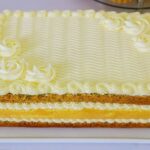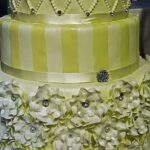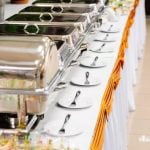Have you ever wondered how to decorate a small cake and make it look just as beautiful as a larger one? Whether you’re making a simple birthday cake for a small gathering or a personalized treat for someone special, knowing the right techniques can make all the difference.
In this article, we will explore the art of decorating small cakes, from choosing the perfect size and shape to adding the finishing touches that will take your creation to the next level.
When it comes to decorating a small cake, there are several factors to consider, from the type of cake you choose to the tools and techniques you use. In this comprehensive guide, we will walk you through everything you need to know to create a stunning small cake that is sure to impress.
From essential tools and supplies to step-by-step instructions for piping, fondant, and other decorative elements, we will cover all aspects of small cake decoration. Whether you’re a beginner looking to improve your skills or an experienced baker in search of new inspiration, this article has something for everyone who wants to elevate their small cake decorating game. So let’s dive in and learn how to turn a small cake into a work of art.
Choosing the Right Cake
When it comes to decorating a small cake, the first step is choosing the right size and shape for your creation. Whether you’re making a mini birthday cake or a petite wedding cake, selecting the perfect base is essential for a successful decorating experience. Here are some important factors to consider when choosing the right cake for your project:
- Size: Consider the number of servings you’ll need and how large or small you want each slice to be.
- Shape: Round, square, heart-shaped, or even petite bundt cakes are all popular options for small cakes. Choose a shape that complements the theme and design of your cake.
- Height: Decide on the height of your cake tiers based on your decorating plans. Taller tiers allow for more intricate decorations, while shorter tiers may be more stable for certain techniques.
Once you’ve decided on the size and shape of your small cake, it’s time to move on to preparing the necessary tools and supplies. From piping bags and offset spatulas to fondant smoothers and edible glitter, having the right items on hand will make the decorating process much smoother.
Remember that selecting the right cake is just the beginning of your small cake decorating journey. In the next section, we’ll explore essential tools and supplies that every aspiring cake decorator should have in their arsenal. With these resources at your disposal, you’ll be well-equipped to bring your creative vision to life on a compact canvas.
Essential Tools and Supplies
When it comes to decorating a small cake, having the right tools and supplies is crucial to achieving professional-looking results. Whether you’re a novice baker or a seasoned pro, there are certain items that are essential for creating beautifully decorated cakes. From piping bags to offset spatulas, here’s a detailed list of the necessary items for decorating a small cake.
Piping Bags and Tips
One of the most versatile tools for decorating a small cake is a piping bag. When paired with different tips, piping bags can be used to create intricate designs, borders, flowers, and more. Make sure to have an assortment of piping tips on hand, including round tips for writing and outlining, star tips for rosettes and swirls, and leaf tips for creating foliage.
Offset Spatula
An offset spatula is an essential tool for smoothly applying frosting to your cake. Its angled blade allows for precision and control when spreading frosting or smoothing out buttercream. Look for an offset spatula with a comfortable handle and a stainless steel blade for easy maintenance.
Fondant Tools
If you plan on using fondant to decorate your small cake, there are several tools that will come in handy. A rolling pin specifically designed for fondant is essential for rolling out the smooth, pliable dough. Fondant smoothers help eliminate wrinkles and air bubbles when covering the cake with fondant, while shaping tools can be used to add texture and detail to fondant decorations.
By ensuring you have these essential tools and supplies at your disposal, you’ll be well-equipped to take on the task of decorating a small cake with confidence and creativity. Remember that investing in quality tools can make a significant difference in the outcome of your decorated cakes.
Preparing the Cake
Once you have chosen the perfect size and shape for your small cake, it’s time to prepare it for decorating. This involves a few essential steps to ensure that your cake is ready to be transformed into a delicious work of art.
First, you’ll want to make sure that your cake layers are level. This can be achieved by using a long serrated knife or a cake leveler to trim off any domed tops. By creating an even surface, you will have a better foundation for stacking and decorating your cake.
Next, consider filling your cake with delicious layers of frosting, fruit compote, or flavored curd. Using a piping bag or offset spatula, evenly spread the filling over each layer before stacking them on top of each other. Be mindful not to overfill the layers as this can cause them to slide and create instability in your cake.
Finally, crumb coating your cake is an important step in achieving a smooth and professional finish. To do this, apply a thin layer of frosting around the entire cake to seal in any crumbs before adding the final layer of frosting. This will create a clean canvas for decorating and result in a polished appearance once completed.
Decorating Techniques
Decorating a small cake is a delightful and creative process, and choosing the right decorating techniques can take your cake to the next level. Whether you’re a beginner or a seasoned baker, mastering piping, fondant, and other decorative elements will allow you to create stunning designs that will impress any guest.
Piping Techniques
Piping is a classic cake decorating technique that involves using a pastry bag and various tips to create intricate designs on the cake’s surface. From simple borders to elaborate floral patterns, piping can add elegance and charm to your small cake. To get started, practice with different types of frosting consistencies and experiment with various piping tips to see which designs you prefer.
Working With Fondant
Fondant is a versatile and easy-to-use medium for decorating cakes. It can be rolled out and draped over the cake for a smooth, polished finish, or molded into intricate shapes and figures for a unique and personalized touch. When working with fondant, be sure to knead it thoroughly before rolling it out, dust your work surface with powdered sugar to prevent sticking, and handle it gently to avoid tears or cracks.
Other Decorative Elements
In addition to piping and fondant, there are countless other ways to embellish your small cake. Edible flowers, chocolate shavings, fresh fruit, edible gold leaf – the possibilities are endless. Consider incorporating textures like ruffles or rosettes using buttercream frosting or experimenting with edible paints for watercolor effects. Don’t be afraid to get creative and think outside the box when it comes to decorating your small cake.
Adding the Finishing Touches
Decorating a small cake is not just about frosting and piping designs; it’s also about adding the perfect finishing touches that will not only enhance the visual appeal but also contribute to the overall taste and experience of the cake. Here are some creative ideas for embellishing your small cake:
- Sprinkles: A classic yet versatile option, sprinkles come in a wide variety of colors, shapes, and sizes. Whether you opt for traditional rainbow sprinkles or shimmering metallic ones, they can add a fun and festive touch to your small cake.
- Edible Flowers: Fresh edible flowers such as roses, violets, or pansies can elevate the aesthetic of your small cake, giving it a touch of elegance and natural beauty. Just make sure they are pesticide-free and safe for consumption.
- Chocolate Shavings: For chocolate lovers, adding delicate chocolate shavings on top of the cake can create a visually appealing contrast while adding a rich and decadent flavor to each bite.
These embellishments can be used individually or combined to create unique and eye-catching designs that will make your small cake truly stand out. Consider the theme or occasion for which the cake is intended when choosing the right embellishments to tie everything together seamlessly. Furthermore, always ensure that any additional elements added to the cake are safe for consumption and complement its flavors.
Presentation
Displaying and photographing a beautifully decorated small cake is just as important as the decorating process itself. After all, the presentation is what makes your creation truly shine. Follow these tips to ensure that your small cake looks as good on the outside as it tastes on the inside.
When it comes to displaying your small cake, consider the setting. Choose a cake stand or plate that complements the theme and colors of your decoration. For example, a rustic wooden stand would be perfect for a vintage-themed cake, while a sleek white plate would work well for a modern design. Additionally, make sure the size of the stand or plate fits the proportions of your small cake – you don’t want it to look overwhelmed or lost.
Photographing your small cake can be a fun and creative process. Natural lighting is key for capturing the true colors and details of your decoration, so try to take photos near a window or outdoors if possible. Experiment with different angles and perspectives to find the most flattering shots of your cake. Consider close-up shots of intricate piping work, as well as overall shots to showcase the entire design.
Remember that presentation goes beyond just how the cake looks – it also involves how it will be served or enjoyed by guests. If serving at an event or party, consider pre-slicing the small cake to make it easier for guests to grab a piece without disrupting its beauty. Alternatively, if it’s being enjoyed at home, accompany it with complementary items like fresh berries or a dollop of whipped cream.
| Displaying Tips | Photographing Tips |
|---|---|
| Choose a complementary cake stand | Use natural lighting for accurate colors |
| Consider size and proportion of display | Experiment with different angles and perspectives |
| Pre-slice for easy serving (if applicable) | Capture close-ups of intricate details |
Bonus Tips and Tricks
When it comes to decorating a small cake, there are a few tips and tricks that can take your skills to the next level. One expert advice is to invest in quality tools and supplies.
From piping bags to fondant smoothers, having the right equipment can make a world of difference in the final result of your decorated small cake. Additionally, taking the time to properly prepare your cake by leveling, filling, and crumb coating will ensure a smooth surface for decorating.
Another expert tip is to experiment with different decorating techniques. Whether it’s mastering intricate piping designs or working with fondant to create 3D decorations, don’t be afraid to try new techniques and expand your skill set. Small cakes provide the perfect canvas for creativity, so take advantage of that and push yourself out of your comfort zone when decorating.
Finally, considering the presentation of your small cake is crucial to taking your decorating to the next level. Pay attention to color schemes, textures, and overall aesthetic when selecting embellishments like sprinkles or edible flowers. And once your small cake is beautifully decorated, take the time to photograph it from different angles in good lighting for an impressive presentation both in person and online.
| Expert Advice Tips | Description |
|---|---|
| Invest in quality tools and supplies | Having the right equipment can make a world of difference |
| Experiment with different decorating techniques | Small cakes provide the perfect canvas for creativity |
| Consider presentation and photography | Select embellishments carefully and photograph from different angles in good lighting |
Conclusion
In conclusion, decorating a small cake can be a fun and rewarding experience. By following the tips and techniques outlined in this article, you can create a beautifully decorated masterpiece that is sure to impress your friends and family. Remember to choose the right cake size and shape, gather all the essential tools and supplies, and carefully prepare the cake before decorating.
Additionally, don’t be afraid to get creative with your small cake decorations. Whether you’re using piping techniques, fondant, or other decorative elements, the possibilities are endless. Adding finishing touches such as sprinkles or edible flowers can take your small cake to the next level and make it truly unique.
Finally, once your small cake is decorated to perfection, be sure to display it proudly and capture it in photographs. Share your creation with others and don’t hesitate to put your newfound skills to use for special occasions or just for fun. With practice and patience, you can become a master at decorating small cakes and impress everyone with your beautiful creations.
Frequently Asked Questions
How to Decorate a Cake for Beginners?
Decorating a cake as a beginner can be simple and fun. Start by choosing a design or theme for your cake, whether it’s for a birthday, holiday, or just for fun. Then, gather the necessary tools such as piping bags, tips, and spatulas.
Consider using simple techniques like frosting with a single color and adding sprinkles or edible decorations. As you gain confidence, you can try more advanced methods such as using fondant or creating intricate designs with different frosting colors.
How Do You Make a Plain Cake Look Fancy?
Making a plain cake look fancy can be achieved through various decorative elements. One way is to use fresh fruits such as berries or sliced kiwi to add color and elegance to the top of the cake.
Another option is to drizzle a glaze made from powdered sugar and flavored extracts over the cake for a glossy finish. Additionally, consider using edible flowers, chocolate shavings, or even gold leaf to make the cake look more sophisticated.
How Do You Frost Mini Cakes?
Frosting mini cakes requires some precision due to their smaller size. One method is to place each mini cake on a wire rack and pour or spread the frosting over the top and sides using an offset spatula for smooth coverage.
Alternatively, you can also pipe small dollops of frosting onto each mini cake for a more decorative look. Just ensure that the frosting is at the right consistency so that it’s easy to work with when decorating the mini cakes.

Welcome to my blog about home and family. This blog is a place where I will share my thoughts, ideas, and experiences related to these important topics. I am a stay-at-home mom with two young children. I hope you enjoy reading it! and may find some helpful tips and ideas that will make your home and family life even better!





